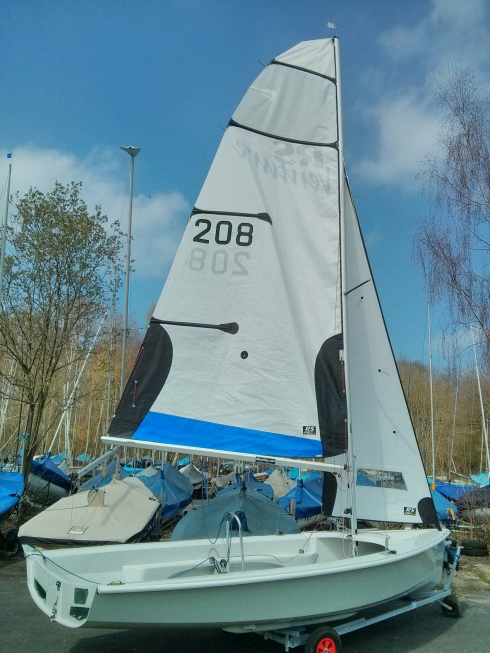Appendix
Index
This section provides mainly technical and maintenance information, usually on accessories, fittings etc that may be used with the Venture dinghy.
The Trolley Roller Assembly
The trolley roller is solid rubber mounted on a galvanised axle, 20mm x 335mm.
The axle is mounted on two welded galvanised brackets and retained in position by washers and 4mm cotter pins at each end. See images of the Trolley roller assembly.
The roller has two end pieces that provide a bearing surface and end spacing.
Roller Dimensions:
- Overall length including end pieces 295mm
- Max width: 90mm
- Min width: 60mm
- Axle width: 355mm
- Axle diameter: 20mm (solid)
- Cotter pins: 4mm
The roller is set in the centre of the rear trolley support rubbers. The height of the rubbers may need to be adjusted to achieve an even weight distribution.See view of rear support system and for a test See this video
The Trolley Jockey wheel
- Tyre 4.10 / 3.50-4 4PR (ply rating)
- Wheel overall diameter 250mm
- Axle 1" diameter
- Wheel with (hub) 80mm include bush shoulders
- Width of wheel cage 112mm
- width of spacer bushes (2 off) 16mm
Note that the wheel depends upon spacing bushes on the axle to keep the wheel central and upright. The spacing bushes tend to wear quickly and need to be replaced before the wheel bearings become damaged.
An option is to use a solid tyre that will withstand the rough treatment better than a pneumatic tyre. However a note of caution when using solid tyres - these work well on a jockey wheel but will be damaged (chunks of rubber torn from the rim) unless the jockey will is properly steered rather than dragged sideways.
Fitting a spare road wheel carrier
It is now a requirement to carry a spare trailer wheel. Whilst packing the spare in the car is an easy option it takes up room and in the event of a puncture may mean unpacking the car to access the spare and also repacking the car with a wet muddy punctured spare.
A carrier is simple to fit and relatively inexpensive and gives easy access to the spare in times of need and frees up car space. There are a variety of carriers on the market but the easiest to fit are those that clamp to the main trailer frame (The Snipe main frame is 30mm x 50mm). The use of clamps is preferable to drilling to avoid weakening the frame. Use stainless steel self-locking nuts to fasten the clamp.
Some considerations when fitting a carrier are i) ground clearance. The boat may be towed over rough ground and road humps so select a carrier that lifts the spare wheel well clear of the ground - if it strikes the ground it could do damage. ii) Position the carrier so that the spare wheel does not protrude beyond the road wheel nor obscure the trailer lights or side reflectors. iii) Mount the carrier on the nearside trailer frame to reduce the amount of time spent exposed to passing traffic in the event of a puncture.
Some images illustrate a typical spare wheel mounting - note also the use of a wheel cover to keep the wheel clean and more importantly prevent sun damage.
Engine mounting plate
The RS Venture is fitted with outboard engine mounting plates on the starboard side of the transom. The outer plate is of stainless steel and is glued onto the transom with contact adhesive. This adhesive is liable to age allowing the plate to fall away. It is worth checking the edges of the plate for lifting or lack of adhesion.
In hot weather my mounting plate simply fell off, fortunately when parked, otherwise it would have been lost. It was refastened by removing the old adhesive, carefully rough sanding the GRP area, avoiding any damage to the hull, and rough sanding the stainless steel plate and applying a hybrid polymer SX adhesive and then clamping firmly in position with a wood block to spread the pressure. Excess adhesive was removed immediately with white spirit. For additional safety I then drilled a blind hole through the stainless steel plate and into the rear panel (note the side panels are not simply fibre glass, they are reinforced with a stainless steel plate sandwiched between the GRP). I then inserted a self tapping stainless steel retaining screw. This extra measure is probably unnecessary because two years later and the plate and adhesive show no signs of coming adrift.
